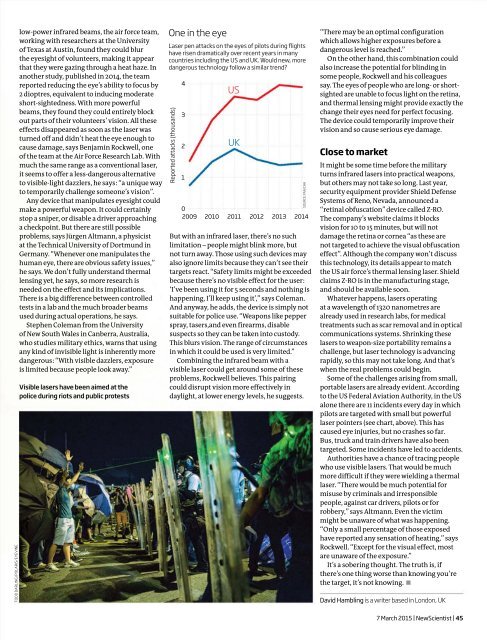New Scientist Magazine - No. 3011
New Scientist Magazine - No. 3011
New Scientist Magazine - No. 3011
Create successful ePaper yourself
Turn your PDF publications into a flip-book with our unique Google optimized e-Paper software.
TODD DARLING/POLARIS/EYEVINElow-power infrared beams, the air force team,working with researchers at the Universityof Texas at Austin, found they could blurthe eyesight of volunteers, making it appearthat they were gazing through a heat haze. Inanother study, published in 2014, the teamreported reducing the eye’s ability to focus by2 dioptres, equivalent to inducing moderateshort-sightedness. With more powerfulbeams, they found they could entirely blockout parts of their volunteers’ vision. All theseeffects disappeared as soon as the laser wasturned off and didn’t heat the eye enough tocause damage, says Benjamin Rockwell, oneof the team at the Air Force Research Lab. Withmuch the same range as a conventional laser,it seems to offer a less-dangerous alternativeto visible-light dazzlers, he says: “a unique wayto temporarily challenge someone’s vision”.Any device that manipulates eyesight couldmake a powerful weapon. It could certainlystop a sniper, or disable a driver approachinga checkpoint. But there are still possibleproblems, says Jürgen Altmann, a physicistat the Technical University of Dortmund inGermany. “Whenever one manipulates thehuman eye, there are obvious safety issues,”he says. We don’t fully understand thermallensing yet, he says, so more research isneeded on the effect and its implications.There is a big difference between controlledtests in a lab and the much broader beamsused during actual operations, he says.Stephen Coleman from the Universityof <strong>New</strong> South Wales in Canberra, Australia,who studies military ethics, warns that usingany kind of invisible light is inherently moredangerous: “With visible dazzlers, exposureis limited because people look away.”Visible lasers have been aimed at thepolice during riots and public protestsOne in the eyeLaser pen attacks on the eyes of pilots during flightshave risen dramatically over recent years in manycountries including the US and UK. Would new, moredangerous technology follow a similar trend?Reported attacks (thousands)4321USUK02009 2010 2011 2012 2013 2014But with an infrared laser, there’s no suchlimitation – people might blink more, butnot turn away. Those using such devices mayalso ignore limits because they can’t see theirtargets react. “Safety limits might be exceededbecause there’s no visible effect for the user:‘I’ve been using it for 5 seconds and nothing ishappening, I’ll keep using it’,” says Coleman.And anyway, he adds, the device is simply notsuitable for police use. “Weapons like pepperspray, tasers,and even firearms, disablesuspects so they can be taken into custody.This blurs vision. The range of circumstancesin which it could be used is very limited.”Combining the infrared beam with avisible laser could get around some of theseproblems, Rockwell believes. This pairingcould disrupt vision more effectively indaylight, at lower energy levels, he suggests.SOURCE: FAA/CAA“There may be an optimal configurationwhich allows higher exposures before adangerous level is reached.”On the other hand, this combination couldalso increase the potential for blinding insome people, Rockwell and his colleaguessay. The eyes of people who are long- or shortsightedare unable to focus light on the retina,and thermal lensing might provide exactly thechange their eyes need for perfect focusing.The device could temporarily improve theirvision and so cause serious eye damage.Close to marketIt might be some time before the militaryturns infrared lasers into practical weapons,but others may not take so long. Last year,security equipment provider Shield DefenseSystems of Reno, Nevada, announced a“retinal obfuscation” device called Z-RO.The company’s website claims it blocksvision for 10 to 15 minutes, but will notdamage the retina or cornea “as these arenot targeted to achieve the visual obfuscationeffect”. Although the company won’t discussthis technology, its details appear to matchthe US air force’s thermal lensing laser. Shieldclaims Z-RO is in the manufacturing stage,and should be available soon.Whatever happens, lasers operatingat a wavelength of 1320 nanometres arealready used in research labs, for medicaltreatments such as scar removal and in opticalcommunications systems. Shrinking theselasers to weapon-size portability remains achallenge, but laser technology is advancingrapidly, so this may not take long. And that’swhen the real problems could begin.Some of the challenges arising from small,portable lasers are already evident. Accordingto the US Federal Aviation Authority, in the USalone there are 11 incidents every day in whichpilots are targeted with small but powerfullaser pointers (see chart, above). This hascaused eye injuries, but no crashes so far.Bus, truck and train drivers have also beentargeted. Some incidents have led to accidents.Authorities have a chance of tracing peoplewho use visible lasers. That would be muchmore difficult if they were wielding a thermallaser. “There would be much potential formisuse by criminals and irresponsiblepeople, against car drivers, pilots or forrobbery,” says Altmann. Even the victimmight be unaware of what was happening.“Only a small percentage of those exposedhave reported any sensation of heating,” saysRockwell. “Except for the visual effect, mostare unaware of the exposure.”It’s a sobering thought. The truth is, ifthere’s one thing worse than knowing you’rethe target, it’s not knowing. ■David Hambling is a writer based in London, UK7 March 2015 | <strong>New</strong><strong>Scientist</strong> | 45


